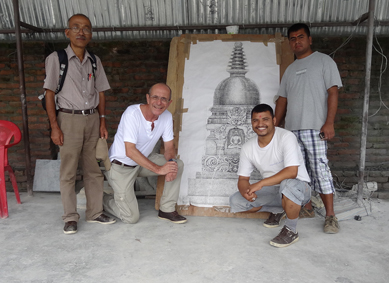Birth and life of a stupa
- magalijenny
- Oct 23, 2021
- 3 min read
Updated: Oct 25, 2021
Text: Sylvia Hobbs-Unternährer, scientific collaborator at the Tibet Museum

This stupa, known in Nepal as chaitya, was commissioned by Alain Bordier, the founder of the Tibet Museum. It was manufactured in Nepal between 2011 and 2013 by the sculptor Santalal Dyahkhah Jyapu of Khokana in the Kathmandu Valley.
The first draft of the design was realized by Ulrich von Schroeder who supervised the manufacture. He asked his friend, the scholar Sukra Sagar Shrestha in Kathmandu, to assist him in the task of finding a suitable artist, and to supervise all the steps of the work in Nepal.
Their search for an appropriate stone for the sculpture took even longer than the search for the sculptor. But after seven months, they located the perfect stone in a quarry four kilometers west of Pharping. The definitive design was made by Rajan Shrestha of Bhaktapur. It took nearly two months to carve out the unnecessary parts of the stone and to bring it into a rough sketch form. About two years after the project started, the chaitya, manufactured in several parts, with a height of 1.8 meters and a weight of approximately 2000 kg, was finished and ready to be sent by air to Switzerland.
It was assembled on site and inaugurated with several precious offerings placed inside the chaitya. These included the navaratna (the nine gems): ruby, pearl, coral, emerald, yellow sapphire, diamond, blue sapphire, hessonite, and cat's eye. Also, magnificent 17th century gilded copper statue of the primordial Buddha Vajradhara (cf. photos) - from central Tibet was sealed inside the chaitya. The consecration ceremony took place on the 1st of July 2014 (the birthday of Alain Bordier and 5th anniversary of the museum) under the supervision of the Tibetan monk Lama Lodreu Rabsel Rimpoche (seconded by Khenpo Losak), a practitioner of the kagyu tradition (cf. photos).

In Tibet, the construction of stupas is an integral part of practiced spirituality. Among the 10 virtues, the first is generosity. A stupa represents the liberated, enlightened mind, and therefore donating a stupa is also offering the Buddha's teachings, which is regarded as particularly meritorious. This particular stupa is a three-dimensional representation of the Vajrayana teaching of Buddhism. Each of the five victorious Buddhas is presiding over one cardinal direction, as well as the centre. These Buddhas are called “victorious” because each of them shows the path to victory over one of the emotions that are the causes of suffering. Stupas are always circumambulated clockwise in a spirit of reverence.
Invisible, Vairocana dwells in the centre of the stupa. He forms the mudra of highest knowledge (bodhyagri-mudra), because he represents the victory over ignorance, which he transforms into the highest intelligence (dharmadhattu-jnana).
In the east we encounter Akshobya. His colour is blue, he sits in the meditation posture and takes the earth as a witness of his concentration (bumisparsa-mudra). He transcends hate and aggression into unshakeable, mirror-like wisdom.
In the south sits Ratnasambhava. His colour is yellow, he transcends pride and shows the gesture of giving (varada-mudra). He transcends pride by the recognition of the essential equality of all living beings.
In the west we find Amitabha. His colour is red and he is engaged in a state of deep meditation (dhyana-mudra). Amitabha represents freedom from attachment which results in a state of immaculate, pure peace.
In the north dwells Amoghasiddhi. His colour is dark green, he triumphs over envy by transforming it into a source of positive action. His quality is infallible energy, dynamism and movement. He holds his right hand in the protective gesture (abhaya-mudra).
On a symbolic level, these five victorious Buddhas represent all aspects of awakening. They express the dynamics of this transformation, in which emotions which are the causes of suffering are transformed into wisdom, and illusions into positive attitudes.
Each of the victorious Buddhas is supported by a yaksha (guardian / atlante), and is surrounded by an archway made of mythical creatures (makaratoranas). A kirtimukha (the "glorious face") closes the arch on the top.


Bibliography:
Beer, Robert (2010): Die Symbole des tibetischen Buddhismus. München: Diederichs, S. 331-332.
Gutschow, Niels (1997): The Nepalese Caitya: 1500 Years of Buddhist Votive Architecture in the Kathmandu Valley. Stuttgart / London: Edition Axel Menges.
von Schroeder, Heidi (2006): Schritte zur Erkenntnis: Neuzugänge der Tibet-Sammlung der Berti Aschmann-Stiftung im Museum Rietberg Zürich. Zürich: Museum Rietberg, S. 21-22.
Thrangu Rimpoche (1998): The Five Buddha Families. In: Namo Buddha Seminar, Boulder Colorado.


































































































































































































Comments